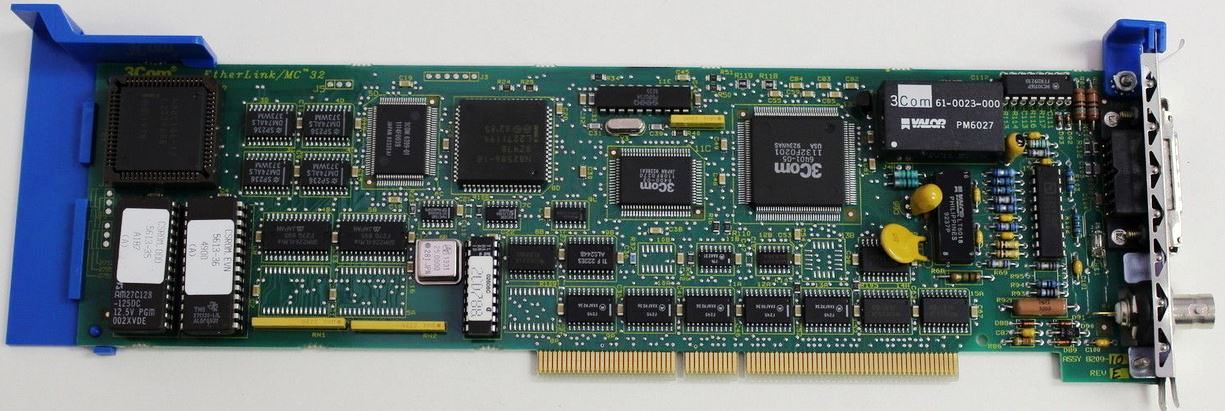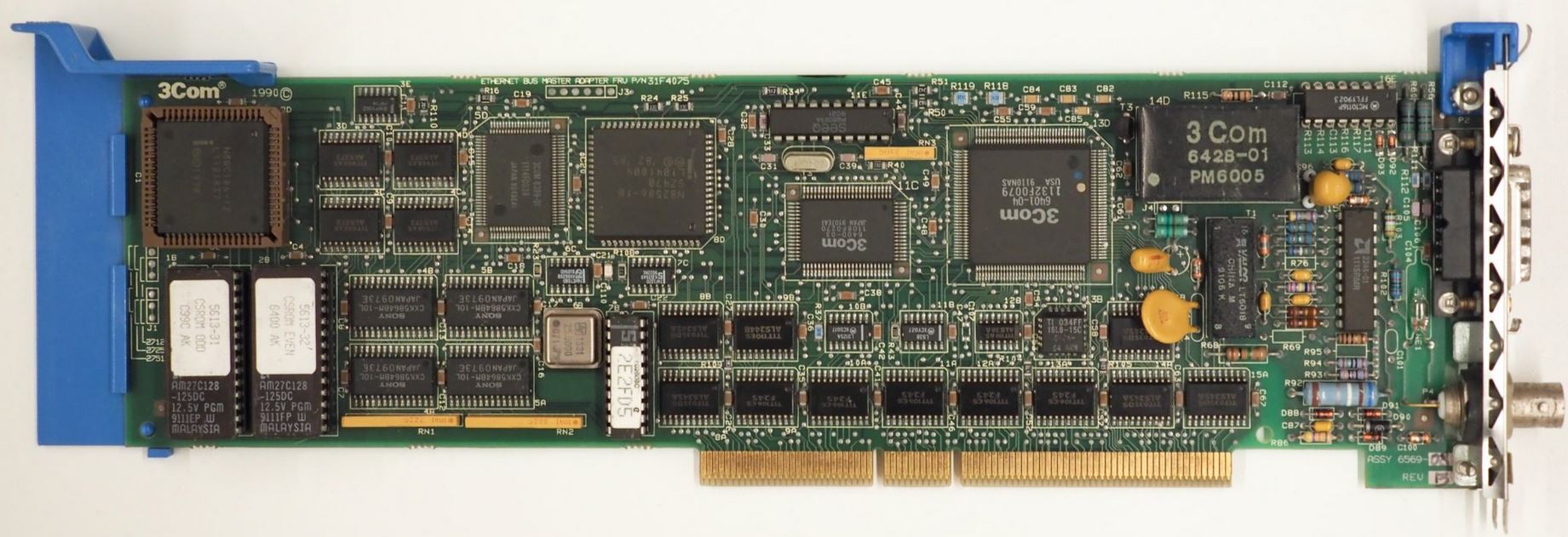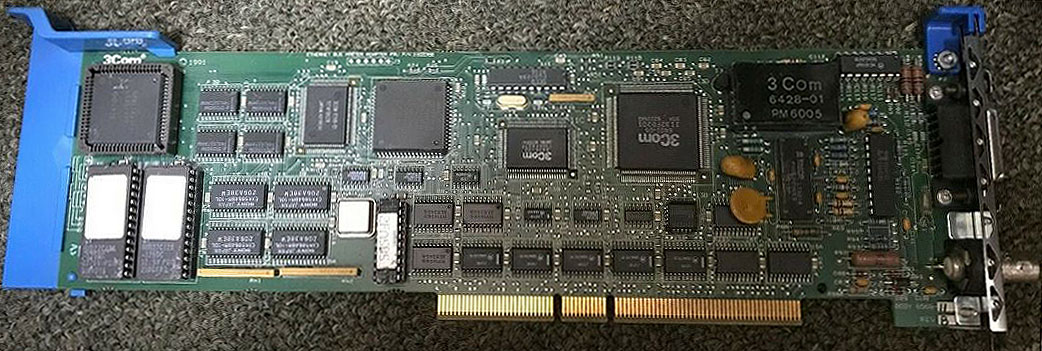|
Note: This page is mostly best guesses. Inferences
have been made from experience, snippets from sources, and SWAGs. As with
anything Micro Channel, we lack documentation on all variants. This page is
VERY incomplete.
@0041.ADF 3Com EtherLink/MC 32 Ethernet Adapter
@8EF5.ADF IBM High Performance Ethernet LAN Adapter (Can't Say)
Note: My SWAG they "Can't Say" this was
a re-badged 3C527 (therefor cheaper)
BINs for 2-1 (thx to Michal Necasek)
3C527X.EXE V3.3 Etherdisk for Etherlink MC/32
3C527N.EXE E-disk version 3.4, includes NT driver
3C527.EXE 3Com EtherLink MC/32 (3C527) NT driver
WFW501.EXE 3C501 or 3C527 (self extracting)
3c527 Technical Reference
Device Driver Issues in High-Performance Networking (AIX 3.2.5)
3C527 Etherlink/MC32
2-1 [31F4075]
3c527 EPROM and Cache
Network Management ROM Format
FC 2980 Versions
ADF Sections
3C527 EtherLink/MC 32


1B CSROM.EVN 5613-33
2B CSROM.ODD 5613-34
2D 80C186-12
3E 74F41 [2-1]
3,4 D/C
4A,5A 8Kx8 CMOS SRAM [2-1]
4B,5B 8Kx8 CMOS SRAM
5D 3Com 6399-01
6B 25.0000 MHz osc
7B NMR / VPD
8A 74ALS245A [2-1]
8D 82586-10
10B LS125A [2-1]
11C 3Com 6400-03
11E SEEQ PQ8023A MCC
|
13B PAL [2-1]
13D 3Com 6401-04
14D 3Com 6428-01
15C AMD 2244
16E MC10116P Triple Line Rcvr
J1 EPROM size
J3 Unknown 6-pin header
J4 Two pin header, unk
NE1 Neon Lamp
P1 AUI
P2 BNC
T1 Valor LT6018
Y 12MHz osc? [Early!]
Y3 20 MHz osc
|
1B / 2B 32K microcode, split over two AMD 27C128-125DC
4B/5B 8Kx8 CMOS Static RAM
7B 3Com's OUI and MAC address
8D Intel 82586 IEEE 802.3 Ethernet LAN Coprocessor
11E SEEQ PQ8023A Manchester Code Converter MCC
16E MC10116P Triple Line Receiver, odd, they used those little press-in pin sockets.
Additional Chips on the 2-1 that are not on 3c527
4A/5A CXK5864BM-10L (8,192-Word x 8-bit High Speed CMOS Static RAM)
8A 74ALS245A Octal transceiver (3-State)
10B LS125A Quad 3-state Buffer
13B 16L8-15C
3E on 81F7913 and 31F4075
74F41 Hex Inverter Schmitt Trigger
Note: Not used on 00G3368
2-1 [31F4075] (thx to Michal Necasek)

3c527 EPROM and Cache

|
| EPROM |
Lower |
Upper |
| 3 - 2 - 1 |
3 - 2 - 1 |
| 27128 |
x - x - o |
x - x - o |
| 27256 |
x - x - o |
o - x - x |
| 27512 |
o - x - x |
o - x - x |
|
After endlessly chanting "Chet Heath" for hours to clear
my mind, I noticed the jumper positions to the left of the
EPROMs. A bit odd, 3Com never changed the PCB, they just
shunted it for a 27128 and called it a day. They could
have changed the foil, shunted it internally.\, then drop
the (unneeded) silk screening, save a few pennies per
card.
The three choices are: 27128, 27256, 27512
Another brilliant blue flash, the 3c527 has TWO
KM6264BL6-10,
8Kx8 bit Low Power CMOS Static RAM (I think). The 2-1
has FOUR 8Kx8. I see other artifacts, some SMD LEDs,
another set of (empty) jumpers....
Michal Necasek Compares "2-1"
to 3C257
Your component 7B is labeled as 2EEF7D.
Mine says 2E2FD5, with 02608C in much smaller print. I
am pretty sure the 7B IC is the PROM holding the MAC
address. 02608C is 3Com's OUI, and the rest is
presumably the remaining 24 bits of the MAC address.
For a moment I was pondering what the big
PROM (32K total) was even for when it's clearly not a
boot ROM, then realized that it has to be microcode for
the on-board 80186. It certainly contains x86 code.
Interesting adapter.
Network Management ROM Access
The 256 byte bipolar Network Management PROM contains
the 48-bit network address value as well as other
pertinent adapter information. Only the Micro Channel's
host processor has access to read the PROM which is
accomplished through the POS mechanism of
sub-addressing--a technique that entails writing 16-bit
address values to POS registers 6 and 7. When the
address values are non-zero, then the Network Management
PROM data is visible to the host through the POS
register bit 3.
IBM 2-1: Vital Product Data ROM containing the network
address and revision information. 3Com 3c527: Network
Management ROM, same fields but different field content.
Differences Between
EtherLink/MC 32 and IBM 2-1
- The 2-1's I.D. number is 8EF5, and the 3c527's is
0041.
- The 2-1 supports exception condition handling such as
parity checking/generation, and the 3c527 does not.
(Ed. probably Selected
Feedback as well...)
- The two products will have slightly different PCB
fabs.
- 2-1 Vital Product Data ROM (network address and
revision info).
3c527 Network Management ROM uses the
same fields but with different field content.
The network management ROM is a hybrid of the Csay ROM.
IT is identical except the first ASCII field has "NMR"
instead of "VPD" and two fields have been added, date
(*DT) and a copyright (*CR). The fields have been filled
with zeroes as place holders for IBM proprietary data.
The Network Management ROM Format is described HERE.
Uli Link on 2-1 Performance
Even on old and slow RS/6000 the 2-1 adapter gives a
throughput close to the theoretical maximum of half-duplex
10MBit/s Ethernet with moderate CPU usage. So if the
busmaster driver (for PC Operating systems) is written
16MByte RAM ISA busmaster safe the adapter does a fast
busmastering into a low mem address buffer and then the
CPU copies the data to the destination (a.k.a. double
buffering) completely wasting all benefits of
busmastering.
I once have tested the 2-1 with Novell Netware 3.12 and
got very good results.
When the drivers was developed such Ethernet cards were
connected to hubs and not switches. You don't need to
fiddle around with fairness on the Ethernet bus on a
switch port. The switch port should generate "collisions"
to slow down the port if the destination cannot handle the
bandwidth at the moment. Those days server adapters were
optimized for combined throughput under heavy load on a
shared media bus.
Programming Form
Rick Ekblaw:
The interface is pretty simple, commands are
mapped to bits and bit groups, there are some command and
status registers starting at the I/O base, there are
mailboxes and so on. It looks a bit like the Spock
interface and a bit like the AHA-154x/164x interface which
uses mailboxes.
Differences Between 3C527 and 2-1
"The IBM adapter supports exception condition handling
such as parity checking/generation, and the EtherLink/MC
32 does not"
Drivers for 2-1
UZnal:
>The 3C527 and this card are the same thing with
different card-IDs.
Now I know where I have seen it, I should have a 3C527.
But then, the type 2-1 card could be assigned to 0041.ADF
renamed to 8EF5.ADF, and the drivers, provided they do not
check the adapter ID, work for the type 2-1 card (if not,
the adapter ID can be patched in the driver object code).
I saw some of the 8EF5 driver code, the POS bytes match
the 0041.ADF quite exactly.
FC 2980 Versions
FRU 81F7913 has P/N 71F1157, 71F1182, 71F1183 - Early
versions
71F1182 has the yellow wire rework, a small
osc to the right of the 80186, pads for J4 and 5, pins for
a jumper under the lower left of the big 3com 6428-01
[14D], J3 populated, populated jumpers for the EPROM size.
Note that 71F1183 looses the small osc to the right of the
80186, no yellow wires.

P/N 71F1182

P/N 31F4073 CE P/N 31F4075 - Intermediate. Needs minimum 3.1.5

FRU 00G3368, P/N 00G3367 - This looks to be the last version
AdapterID 0041 3Com EtherLink/MC 32 Ethernet Adapter
Enable/Disable Adapter
Use disabled if you are not using the
adapter in your system
<"Adapter
Enabled">, Adapter Disabled
I/O Base Address
The EtherLink/MC 32 occupies 16 bytes in
the I/O Address space.
< "728x"
(7280-728f)>, 729x (7290-729f), 768x
(7680-768f), 769x (7690-769f), 7A8x (7a80-7a8f), 7A9x
(7a90-7a9f), 7E8x (7e80-7e8f), 7E9x (7e90-7e9f)
Shared Memory Ranges
A 16K memory window is required, located at
any of eight possible address ranges.
<"RANGE:D800-DBFF,
16K">, DC00-DFFF, 16K, C000-C3FF, 16K,
C400-C7FF, 16K, C800-CBFF, 16K, CC00-CFFF, 16K,
D000-D3FF, 16K, D400-D7FF, 16K
Interrupt Level
Interrupts can be shared with another
device, if the software drivers for both devices
support interrupt sharing. You may be able to
improve performance by selecting a level that is not
used by another device.
<"Level
10">, 11, 9, 12
Arbitration Level
Level eight has the highest priority, and
higher levels decrease priority
<"Level
10">, 11, 12, 13, 14, 8, 9
Fairness Enable
Fairness is provides equal access is to the
host bus for competing bus masters and in most instances
should be enabled. In a system where it is desired
that a higher priority device have increased bus
utilization, fairness may be disabled.
<"Enabled
" >, Disabled
Address Burst Management
This enables the Etherlink/MC 32 to
relinquish control of the Micro Channel Bus at specific
address boundary crossings. As an example, if the
16-byte boundary Address Burst Management is selected,
the Bus Master relinquishes bus control as the address
increments from xx0Fh to xx10h. In some system
configurations, the Address Burst Management feature may
provide improved performance, but generally it should be
disabled.
<"Disabled">,
16-byte boundary, 32-byte boundary, 64-byte boundary
Transceiver Type
The active connector is determined by the
selection of the Transceiver Type. If you have a thin
ethernet network and wish to connect using a
T-connector, select On-board. If you have the
thick drop cable from an external transceiver and wish
to attach to the 15-pin AUI cable, select External
<"On-board
Transceiver (BNC)>, External Transceiver
(AUI)
|